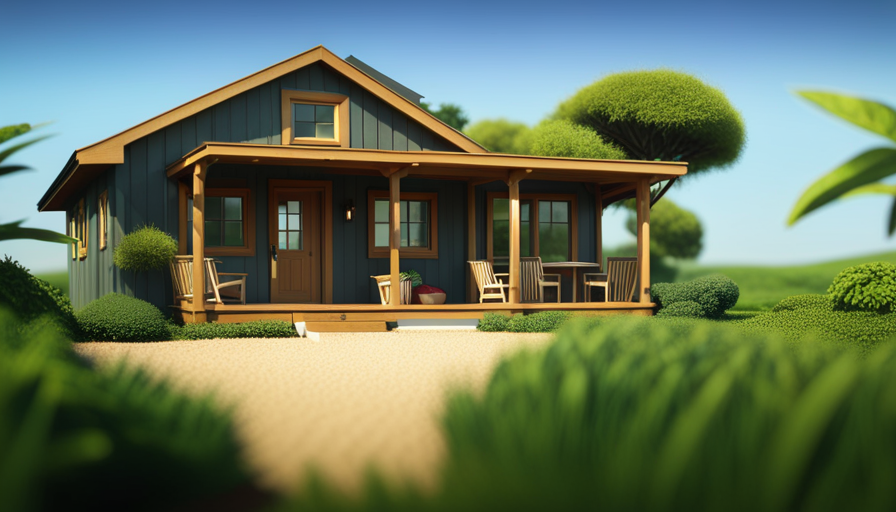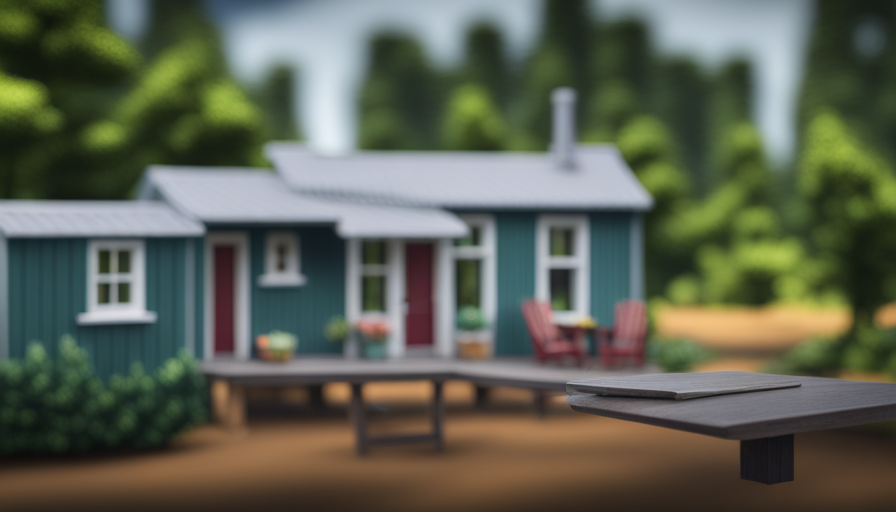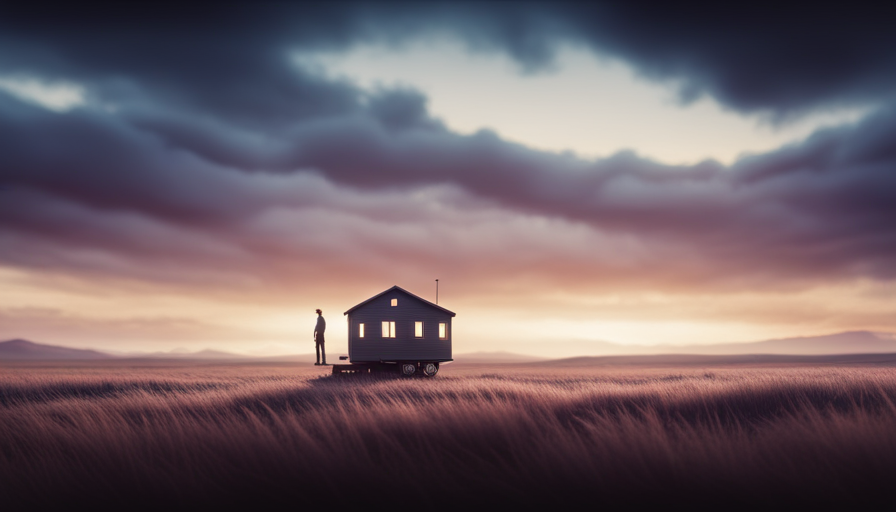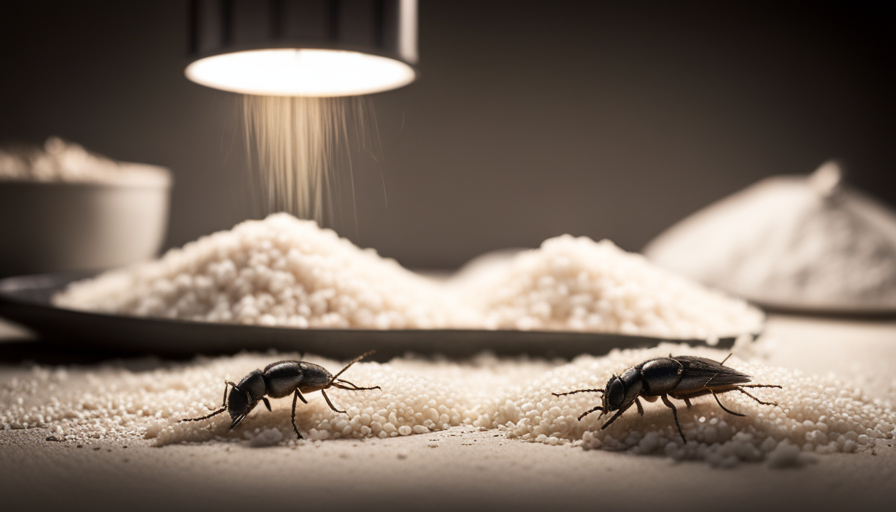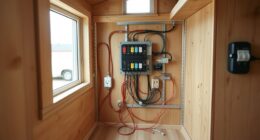Many people believe that the greatest things come in small packages. But when it comes to tiny houses, how small is too small for a living space? This is a common question for those considering transitioning to tiny house living. When you’re planning to enter this lifestyle, it’s important to carefully consider the size of your future home. To help with this decision, the ‘How Big Should My Tiny House Be Quiz’ is a valuable tool.
This quiz is designed to help you assess your lifestyle, needs, and priorities to determine the perfect size for your tiny abode. In this article, we’ll explore the key factors to consider when deciding on the size of your tiny house. From assessing your living space requirements to researching local regulations, we’ll guide you through the decision-making process.
So let’s dive in and find out just how big your tiny house should be!
Key Takeaways
- Lifestyle factors and storage needs should be considered when determining the size of a tiny house.
- Future plans, such as starting a family, should also be taken into account.
- Budget and financial considerations, including the cost of materials and permits, are important factors to consider.
- Achieving future growth and flexibility through a flexible floor plan, modular construction, and outdoor living space is recommended.
Assess your Lifestyle and Needs
Take a moment to reflect on your lifestyle and ponder what you truly need in order to live comfortably in a tiny house. Assessing your priorities and considering lifestyle factors is crucial when determining the size of your tiny house.
Start by asking yourself how much time you spend at home and what activities you enjoy. If you work long hours and spend most of your time outside, you may not need as much indoor space. On the other hand, if you enjoy cooking, entertaining guests, or have hobbies that require a lot of room, you may need a larger tiny house.
Consider your storage needs as well. Are you the type of person who collects a lot of belongings or do you prefer a minimalist lifestyle? If you have a lot of possessions, you will need to factor in additional storage space.
Also, think about your future plans. Are you planning to start a family or will you be living alone? This will affect the number of bedrooms and overall space required.
Once you have assessed your lifestyle and determined your priorities, you can move on to considering your living space requirements.
Consider your Living Space Requirements
Consider your space needs and requirements when determining the appropriate size for your compact dwelling. When it comes to living in a tiny house, every square inch matters.
Start by evaluating your living space requirements. Think about how many people will be living in the house and what activities you’ll be doing on a daily basis. Do you need a separate workspace or a designated area for hobbies? Will you be entertaining guests frequently? These factors will help you determine how much space you actually need.
Additionally, don’t forget to take into account your personal preferences. Some people prefer a minimalist lifestyle with only the essentials, while others may need more storage space for their belongings. Consider what’s important to you and what’ll make you feel comfortable in your tiny home.
By carefully considering your living space requirements and personal preferences, you can determine the ideal size for your tiny house. This’ll ensure that you have enough space to live comfortably without feeling cramped.
Once you’ve determined the appropriate size, you can move on to the next step of determining your budget and financial considerations, which’ll help you bring your tiny house dreams to reality.
Determine your Budget and Financial Considerations
Planning your budget and financial considerations is crucial to avoid sinking into a bottomless pit of debt when bringing your tiny house dreams to life. Before embarking on the journey of building your tiny house, it’s important to determine your financial limitations. Consider how much you’re willing and able to spend on your project, taking into account not only the cost of materials and labor, but also any permits or fees that may be required.
Additionally, think about your long-term financial goals. Will building a tiny house allow you to save money in the long run? Or will it hinder your ability to achieve other financial milestones, such as saving for retirement or starting a family?
By carefully evaluating your budget and financial considerations, you can ensure that your tiny house project aligns with your overall financial plan. It’s essential to strike a balance between creating your dream home and staying within your means. Remember, building a tiny house shouldn’t put you in a precarious financial situation. Instead, it should be a step towards financial freedom and flexibility.
Now, let’s think about future growth and flexibility in your tiny house design.
Think about Future Growth and Flexibility
Imagine the possibilities of expanding and adapting your tiny house design to accommodate future growth and changing needs. One of the advantages of a tiny house is its potential for future expansion. With careful planning and design, you can create a space that can be easily modified and expanded as your needs change over time.
Here are three key considerations for future growth and adaptability:
-
Flexible Floor Plan: Design your tiny house with a flexible floor plan that can easily be reconfigured to accommodate additional rooms or spaces. Consider using movable walls or furniture that can be rearranged as needed.
-
Modular Construction: Opt for a modular construction approach, where sections of your tiny house can be easily added or removed. This allows for effortless expansion without having to rebuild the entire structure.
-
Outdoor Living Space: Create an outdoor living area that can be used as an extension of your tiny house. This can include a deck, patio, or garden, providing additional space for entertaining or relaxing.
By considering future expansion and adaptability in your tiny house design, you can ensure that your living space will continue to meet your needs as they evolve.
Next, we’ll explore how to research local zoning and building regulations to ensure compliance.
Research Local Zoning and Building Regulations
To ensure that your tiny house complies with local zoning and building regulations, it is crucial to thoroughly research the specific requirements and restrictions in your area. This research process will help you understand what is allowed and what is not, ensuring that you can build your tiny house without any legal issues. Local regulations vary widely, so it’s important to consult the appropriate authorities or resources to get accurate information.
One effective way to research local zoning and building regulations is to visit your city or county’s website. They often provide detailed information on the requirements for tiny houses, such as minimum square footage, setback requirements, and utility connections. Additionally, you can reach out to the local planning department for further guidance and clarification.
Another valuable resource is the International Residential Code (IRC), which is used as a guideline for building codes in many areas. It provides standards for construction, safety, and occupancy, including regulations for tiny houses. By familiarizing yourself with the IRC, you can ensure that your tiny house meets the necessary standards.
Researching local zoning and building regulations is a crucial step in the process of building a tiny house. It helps you understand the limitations and possibilities in your area, and ensures that your tiny house will be legally compliant. Once you have a good grasp of the regulations, you can consult with a tiny house designer or builder to move forward with your project.
Consult with a Tiny House Designer or Builder
Consider reaching out to a reputable tiny house designer or builder who can provide expert guidance and ensure that your project meets all necessary requirements. Consulting with a professional in the field has several benefits.
First, they have extensive knowledge and experience in designing and building tiny houses. They can provide valuable insights and suggestions based on their expertise, helping you create a functional and efficient living space.
Second, a designer or builder can assist you in navigating the complex world of zoning and building regulations. They can help you understand the specific requirements for your area and ensure that your tiny house complies with all necessary codes.
Lastly, working with a professional allows you to tap into their network of suppliers and contractors. They can recommend trusted vendors and connect you with skilled tradespeople who specialize in building tiny houses. By finding the right builder or designer, you can save time and ensure that your tiny house project is a success.
With their guidance, you can explore different layouts and floor plans that suit your needs and preferences seamlessly.
Explore Different Layouts and Floor Plans
Explore a variety of layouts and floor plans that will perfectly suit your unique needs and preferences when designing your dream tiny house.
When it comes to tiny houses, the design is crucial in maximizing space and creating a functional living environment. There are countless different designs available, each offering its own set of advantages and disadvantages.
Whether you prefer an open floor plan, a lofted sleeping area, or a multi-purpose layout, there is a design out there that will meet your requirements.
One popular layout option is the open floor plan, which combines the kitchen, living area, and bedroom into one cohesive space. This design allows for a more spacious feel and encourages a sense of togetherness.
Alternatively, a lofted sleeping area is an excellent choice for those who want to maximize floor space and create a separate sleeping zone. This design utilizes vertical space, leaving the main floor open for other activities.
As you explore different floor plans, consider how they will fit into your lifestyle and daily activities. Think about your storage needs, entertaining possibilities, and any specific requirements you may have.
Once you have explored various designs, you can move on to prioritizing essential features and amenities, ensuring that your tiny house is tailored to your unique preferences and lifestyle.
Prioritize Essential Features and Amenities
When creating your dream tiny house, make sure to prioritize the essential features and amenities that will truly make it feel like a luxurious retreat, fit for a king or queen. Designing for minimalism is key in maximizing space efficiency in a tiny house. Every square inch counts, so it’s important to carefully consider what features and amenities are truly essential for your lifestyle.
Start by making a list of the must-haves in your tiny house. Think about how you’ll be using the space and what activities are most important to you. For example, if you love cooking, prioritize a functional kitchen with space-saving appliances and ample storage. If relaxation is your priority, consider a comfortable seating area or a cozy loft bed.
When it comes to designing for minimalism, think about multi-functional furniture and clever storage solutions. Opt for furniture pieces that can serve multiple purposes, such as a sofa that can be transformed into a bed or a coffee table with built-in storage. Use vertical space to your advantage by installing shelves or cabinets that reach the ceiling.
By prioritizing essential features and amenities and designing for minimalism, you can create a tiny house that maximizes space efficiency without sacrificing comfort or style.
In the next section, we’ll take into account storage solutions and organization, ensuring that every item has its place and clutter is kept at bay.
Take into Account Storage Solutions and Organization
To truly make your dream tiny house feel like a luxurious retreat, prioritize storage solutions and organization, ensuring that every item has its place and clutter is kept at bay.
Storage is a crucial aspect of tiny house living, as limited space requires creative solutions. Consider utilizing multi-functional furniture, such as beds with built-in storage or ottomans that double as storage containers. Install shelves and hooks on walls to make use of vertical space, and utilize under-bed storage bins or hanging organizers. Additionally, think about implementing clever storage solutions in often overlooked areas, such as utilizing the space under stairs or creating storage compartments in walls.
Organization is equally important, as it helps maintain a tidy and functional living space. Invest in storage containers and labels to keep items categorized and easily accessible. Consider implementing a minimalist lifestyle and regularly decluttering to prevent accumulation of unnecessary items.
By prioritizing storage solutions and organization, your tiny house will feel spacious and clutter-free, allowing you to fully enjoy your living space.
Trust your instincts and choose the size that feels right for you, ensuring that your tiny house is a perfect fit for your lifestyle and needs.
Trust your Instincts and Choose the Size that Feels Right for You
Consider trusting your instincts and selecting the size that truly feels perfect for you, allowing you to fully embrace and enjoy the experience of living in your dream tiny house. When it comes to determining the ideal size for your tiny house, it’s crucial to evaluate your personal preferences and trust your intuition.
Here are a few key points to consider:
-
Personal Space: Think about how much personal space you need to feel comfortable. Are you someone who enjoys solitude and needs a quiet corner to retreat to? Or do you prefer a cozy, intimate space where everything is within arm’s reach?
-
Functionality: Consider how you plan to use your tiny house. Will it be a permanent residence or a vacation home? Will you be working from home or pursuing hobbies that require additional space? Make sure the size accommodates your intended lifestyle.
-
Storage Needs: Assess your storage requirements. Are you someone who collects possessions or do you prefer a minimalist lifestyle? Think about how much storage space you need for your belongings and whether you are willing to downsize.
-
Energy Efficiency: Smaller houses are generally more energy-efficient. Consider the impact you want to have on the environment and whether a smaller footprint aligns with your values.
-
Financial Considerations: Finally, evaluate your financial situation and determine what size fits within your budget. Remember that a smaller house often means lower costs for construction, maintenance, and utilities.
By trusting your instincts and carefully evaluating these factors, you can confidently choose the size that feels right for you, ensuring that your tiny house becomes a haven that perfectly suits your needs and desires.
Frequently Asked Questions
How much will it cost to build a tiny house?
The cost of building a tiny house can vary greatly depending on factors such as location, materials used, and level of customization. It is important to consider all the expenses involved, including land, permits, utilities, and construction materials.
Financing options such as personal loans, RV loans, or crowdfunding can help cover the costs. Conducting thorough research and obtaining cost estimations from multiple sources will give you a clear idea of how much it’ll cost to build your dream tiny house.
Can I legally live in a tiny house on wheels in my area?
Yes, I can legally live in a tiny house on wheels in my area. However, it’s important to research and be familiar with the tiny house building codes specific to my region.
Living in a tiny house on wheels has its pros and cons. On the positive side, it offers flexibility, mobility, and a simpler lifestyle. However, it may also have limitations in terms of space, zoning regulations, and access to utilities.
What are some common challenges or drawbacks of living in a tiny house?
Challenges and space limitations are common drawbacks of living in a tiny house. With limited square footage, it can be a struggle to find storage space for belongings or have enough room for everyday activities.
The lack of space may also cause feelings of claustrophobia or restrict the ability to entertain guests. Additionally, living in a tiny house requires careful organization and minimalism to make the most of the available space.
Are there any specific zoning or building regulations that I need to be aware of in my area?
When considering building a tiny house, it’s crucial to familiarize oneself with the various zoning regulations and building codes in your area. These guidelines ensure the safety and legality of your construction project.
Zoning regulations dictate where you can build your tiny house and what it can be used for, while building codes outline the specific requirements for construction and design. Adhering to these regulations is essential to avoid any legal or structural issues in the future.
What are the most important factors to consider when choosing a layout for a tiny house?
When choosing a layout for a tiny house, space optimization and functional storage are key factors to consider. Maximizing every square inch is crucial, so it’s important to think about how each area can serve multiple purposes. Look for clever storage solutions like built-in cabinets or under-bed storage.
Additionally, consider open floor plans that create a sense of spaciousness and allow for flexible use of the space. Efficiently utilizing every nook and cranny will help make your tiny house feel comfortable and organized.
Conclusion
After carefully considering all the factors, it’s clear that determining the size of your tiny house is a personal decision. It should be based on your lifestyle, needs, budget, and future plans. By assessing your requirements, researching local regulations, and exploring different layouts, you can make an informed choice that suits you.
Remember to prioritize essential features, consider storage solutions, and trust your instincts. Ultimately, the size of your tiny house should evoke a sense of comfort, functionality, and happiness. This will ensure a fulfilling living experience.
Hi, I’m Emma. I’m the Editor in Chief of Tiny House 43, a blog all about tiny houses. While tree houses are often associated with childhood, they can be the perfect adult retreat. They offer a cozy space to relax and unwind, surrounded by nature. And since they’re typically built on stilts or raised platforms, they offer stunning views that traditional homes simply can’t match. If you’re looking for a unique and romantic getaway, a tree house tiny house might just be the perfect option.
